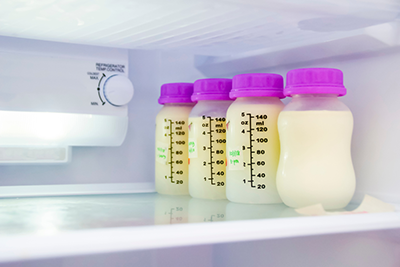 Despite significant efforts to prevent mix-ups, occasionally, expressed breast milk from a mother is given to another mother's child in error. If a child is mistakenly fed another child's bottle of expressed breast milk, such as in a childcare setting, sensitivity should be taken with both families to minimize fear and steps should be taken to appropriately manage the situation in a timely manner.
Despite significant efforts to prevent mix-ups, occasionally, expressed breast milk from a mother is given to another mother's child in error. If a child is mistakenly fed another child's bottle of expressed breast milk, such as in a childcare setting, sensitivity should be taken with both families to minimize fear and steps should be taken to appropriately manage the situation in a timely manner.
Few illnesses are transmitted via breast milk, and in fact, the unique properties of breast milk help protect infants from colds and other typical childhood viruses. Nonetheless, both families need to be notified when there is a milk mix-up, and they should be informed that the risk of transmission of infectious diseases via breast milk is small.
CDC's experts recommend health care and childcare providers take specific actions as soon as possible after this kind of error to prevent adverse health consequences. If a child mistakenly fed another child's expressed breast milk, follow these steps:
- Inform the mother whose breast milk was given to another child, and ask her:
- When was the breast milk expressed and how was it handled prior to being delivered to the caretaker or facility?
- Would she be willing to share information about her current medication use, recent infectious disease history, and presence of cracked or bleeding nipples during milk expression with the other family or the child's pediatrician?
- Discuss the event with the parent(s) or guardian(s) of the child who was given another mother's milk:
- Inform them that their child was given another mother's expressed breast milk.
- Inform them that the risk of transmission of infectious diseases is small.
- If possible, provide the family with information on when the milk was expressed and how the milk was handled prior to being delivered to the caretaker.
- Encourage the parent(s) or guardian(s) to notify the child's physician of the situation and share any specific details known.
When a milk mix-up occurs, any decisions about medical management and diagnostic testing of the infant who received another mother's milk should be based on the details of the individual situation and be determined collaboratively between the infant's physician and parent(s) or guardian(s).
Potential Concerns Related to Breast Milk Mix-Ups
Concerns about potential exposure to human immunodeficiency virus (HIV)
Routine prenatal care in the United States includes laboratory testing for sexually transmitted infections (STIs) and HIV. Most HIV-positive women are identified prior to or during their maternity hospital stay. In the United States, women who are HIV-positive are advised NOT to breastfeed their infants. As such, it is unlikely that a mother living with HIV would be providing expressed milk for her own child at a child care center. In addition, the risk of mother-to-child transmission for whom a single bottle of another mother's milk was fed is very low. The CDC is unaware of any evidence of transmission of HIV to a child via single exposure to another mother's milk.
Concerns about potential exposure to hepatitis B and C viruses
Hepatitis B and C cannot be spread from a woman to a child through breastfeeding or close contact unless there is exposure to blood. It is very unlikely that a child would be at risk for hepatitis B or C by receiving another mother's breast milk. Furthermore, with regard to hepatitis B (there is no vaccine for hepatitis C), most infants have already received at least one dose of the hepatitis B vaccine shortly after birth, the second dose between one to two months of age, and the third dose between six to 18 months of age. However, infants who have no been vaccinated, or infants whose vaccine schedule was interrupted, should be vaccinated according to the Advisory Committee on Immunization Practices' hepatitis B vaccine recommendations as soon as possible.
There is no evidence that breastfeeding spreads hepatitis C virus.
Concerns about potential exposure to medications
Although many medications do pass into breast milk, most have little or no effect on infant well-being. Few medications are contraindicated while breastfeeding and risk of adverse effects from a single exposure to a medication through breast milk is very low.
Prevent Milk Mix-Ups
To help prevent milk mix-ups, childcare facilities should review and update their policies and practices for storing and handling breast milk, as well as training (or retraining) all childcare facility staff in safe storage and handling of breast milk. In addition to clearly labeling expressed breast milk with the child's name, some facilities use strategies such as putting different colored rubber bands around the bottles for different infants and using separate bins for each infants bottles of milk.
